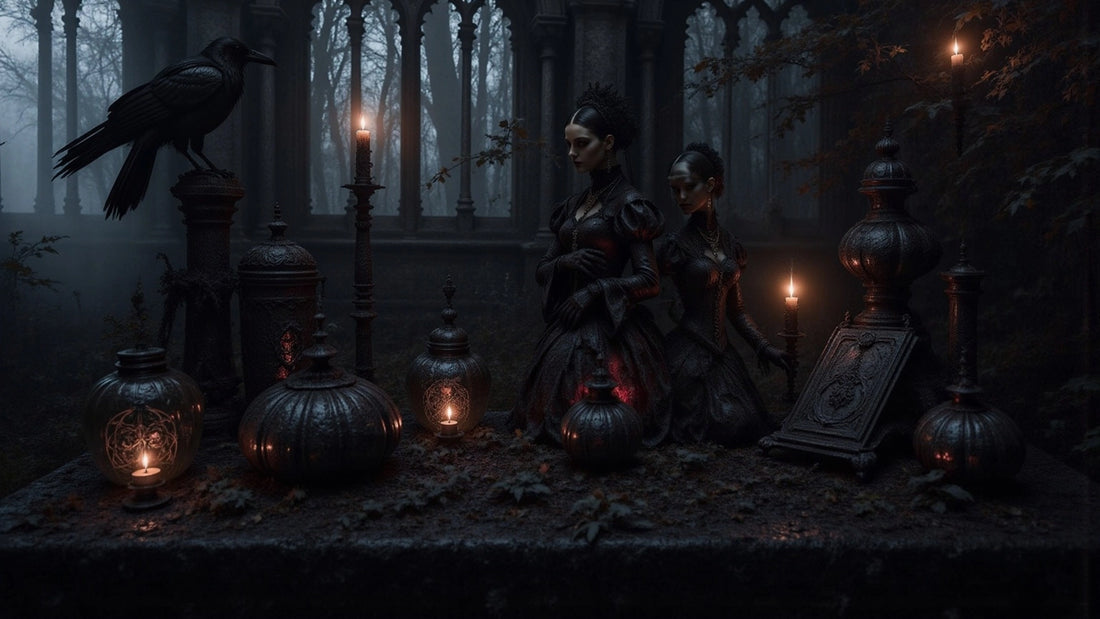
10 Essential Gothic Rock Songs That Define the Genre
Share
Overview
Dive into the shadows of sound as we unveil ten essential gothic rock anthems that define the genre. Each track—like Bauhaus's 'Bela Lugosi's Dead' and The Cure's 'A Forest'—is a haunting echo of darkness, emotional depth, and a fusion of styles. These songs don’t just play; they resonate, weaving a rich tapestry of influence that challenges the very fabric of musical norms.
What do these tracks whisper about our deepest fears and desires? Discover the unique characteristics and cultural significance that make gothic rock a timeless experience, inviting you to explore the depths of its sonic allure.
Introduction
Gothic rock—where haunting melodies entwine with shadowy themes—has carved a niche in the music landscape, ensnaring listeners with its intoxicating blend of darkness and beauty. This genre, defined by evocative soundscapes and lyrical depth, invites you to plunge into the emotional complexities of love, loss, and existential dread.
As the boundaries between punk, metal, and dark romanticism dissolve, one must ask: which songs truly encapsulate the essence of gothic rock and its enduring influence? This article plunges into ten essential tracks that not only define the genre but resonate deeply with those drawn to its enigmatic allure.
Bauhaus: 'Bela Lugosi's Dead' - The Anthem of Gothic Rock
Released in 1979, 'Bela Lugosi's Dead' by Bauhaus is not just a song; it's a haunting anthem that embodies the dark rock genre's seductive allure. With minimalist instrumentation—a repetitive bassline and sparse guitar work—it conjures an eerie atmosphere that lingers like smoke in the night. Clocking in at 9 minutes and 36 seconds, it boldly defies the musical norms of its era.
Peter Murphy's vocals are a chilling homage to the legendary actor who brought Dracula to life, weaving a narrative that revels in the macabre. This track is steeped in somber motifs and an immersive soundscape, establishing its place as a cornerstone of dark culture. It resonates deeply with those who find beauty in horror, inviting listeners into a world where shadows of the past dance with the grotesque, embracing themes of death and decay.
'Bela Lugosi's Dead' is a defining piece of gothic rock songs, acting as a siren call to explore the depths of darkness. Its influence is undeniable, inspiring artists like The Cure and Siouxsie and the Banshees, and shaping the very fabric of dark music, particularly through gothic rock songs. Ranked #60 in Rolling Stone's 'The 100 Greatest Debut Singles of All Time,' its cultural significance is further cemented.
The track's haunting presence in the film 'The Hunger' (1983) underscores its impact, weaving its legacy into both music and cinema. This timeless classic continues to captivate audiences, a testament to its power and allure that beckons you to listen, to feel, to embrace the shadows.
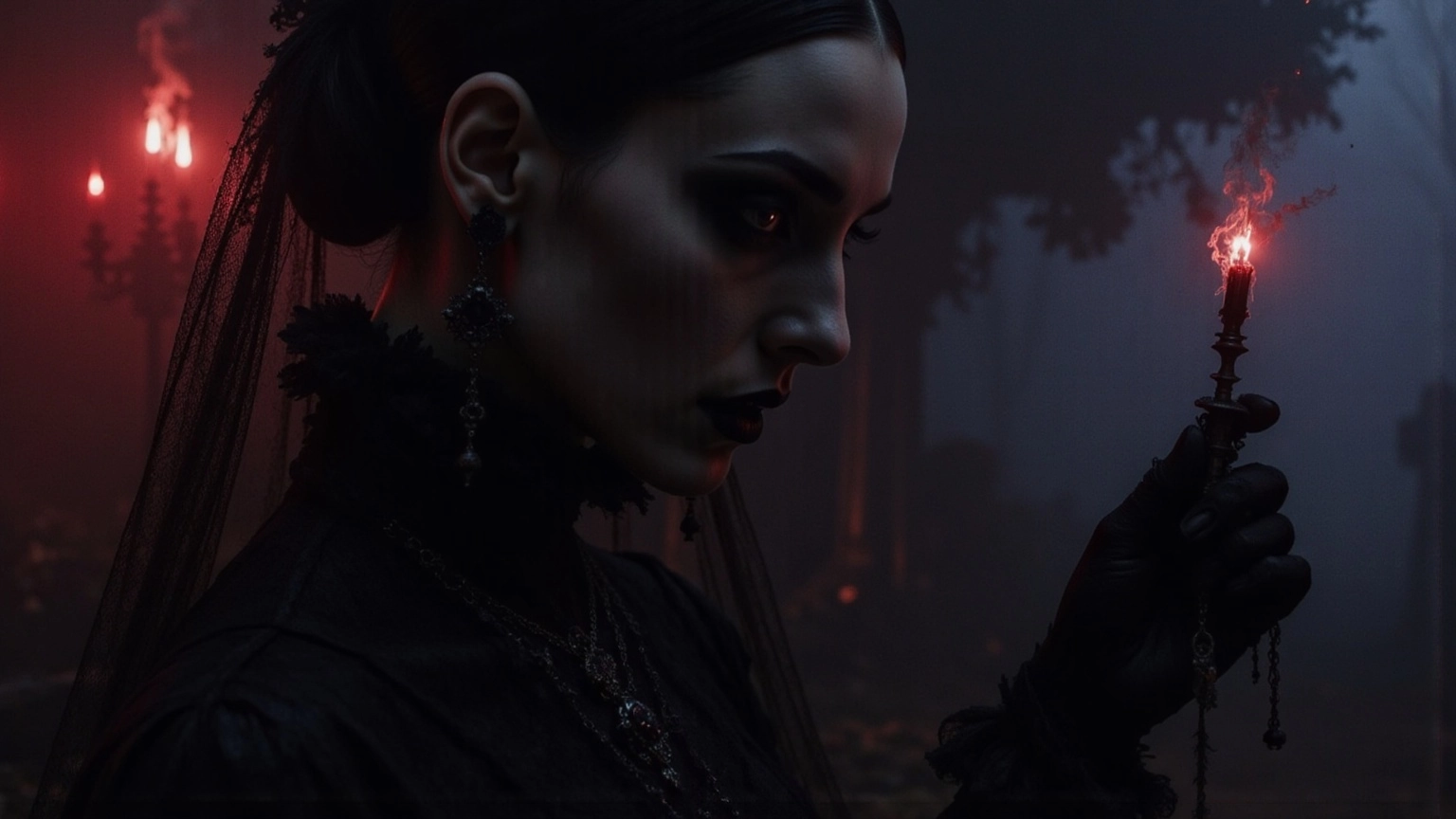
The Cure: 'A Forest' - A Haunting Exploration of Isolation
A Forest' by The Cure, released in 1980, is not just a song; it’s a haunting journey through isolation and yearning. The repetitive guitar riff intertwines with Robert Smith's ethereal voice, pulling you into a dark, enchanted forest where you feel utterly lost. The lyrics? They echo the desperate search for something elusive, a mirror reflecting the struggles of those disconnected from the world around them. Conflicting interpretations from Smith himself add to the mystique—was it born from a childhood nightmare, or is it merely a reflection of a forest? This ambiguity layers the meaning, inviting deeper contemplation.
In the realm of gothic rock songs, this track stands as a testament to how music can delve into profound emotional experiences. Sparse lyrics amplify the haunting atmosphere, leaving an indelible mark on the listener. Its presence in films and TV shows only cements its cultural significance and allure. And those final moments? They resonate with existential dread, the notion of running toward nothingness, reinforcing the song's exploration of isolation and futility. 'A Forest' isn’t just a song; it’s a timeless classic that continues to haunt and inspire, beckoning you to explore the shadows within.
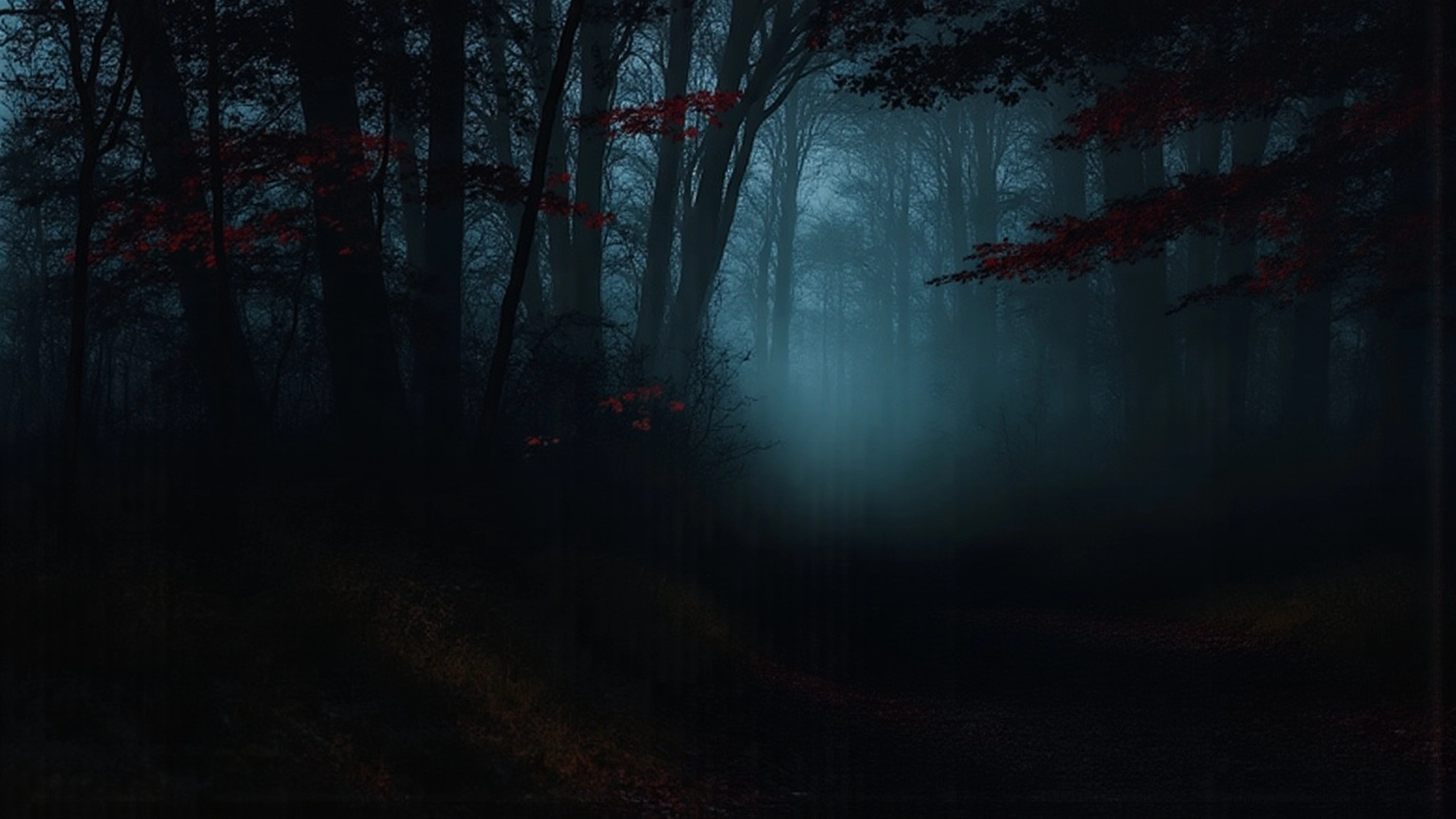
Siouxsie and the Banshees: 'Spellbound' - A Fusion of Punk and Gothic Aesthetics
Siouxsie and the Banshees' 'Spellbound,' unleashed in 1981, is a vibrant testament to the electrifying fusion of punk energy and dark aesthetics. This track pulses with driving rhythms, propelled by Siouxsie's distinctive vocals, crafting an atmosphere thick with enchantment and allure. Obsession and desire weave through the lyrics, capturing the shadowy facets of love. Here lies a sound that not only showcases the band's creative prowess but also reveals the fluidity of dark music—where punk's raw intensity collides with haunting elegance.
The arrangement of 'Spellbound' bursts forth with newfound freedom, as John McGeoch's inventive guitar work casts a foreboding tone through phased arpeggios and unique chord voicings. As a cornerstone of the dark music tradition, 'Spellbound' has left an indelible mark on the aesthetics of gothic rock songs, creating a powerful link between punk's defiance and its reflective depth. Its influence resonates, shaping the evolution of dark music into subgenres like Darkwave and Deathrock, mirroring the cultural currents of introspection and existential disillusionment that define this haunting realm.

Joy Division: 'Love Will Tear Us Apart' - The Dark Heart of Post-Punk
Love Will Tear Us Apart' by Joy Division—released in 1980—haunts the air with its chilling exploration of love and despair. This track isn't just music; it's a melancholic melody that intertwines with Ian Curtis's evocative vocals, crafting an atmosphere thick with emotional turmoil.
Dive into its lyrics, and you'll find a raw reflection on the complexities of relationships and the shadows of mental health struggles, resonating with those who are drawn to love's darker corners. This anthem, considered a cornerstone of gothic rock songs, powerfully articulates human experiences marked by pain and longing.
With over 2,173 plays, it continues to inspire introspective songwriting, standing tall as a beacon for those navigating the intricate dance of love and despair, reminiscent of gothic rock songs. Recent discussions underscore its enduring significance, evoking potent emotional responses and serving as a cultural touchstone for both devoted fans and curious newcomers.
The track's impact doesn't stop there; its chart success—2× Platinum in the UK for 1,200,000 units sold—solidifies its classic status in the post-punk genre. And let’s not forget its ripple effect—artists like Peter Hook & the Light and Nouvelle Vague have drawn inspiration from it, showcasing its lasting influence across generations.
What does this say about the power of music? It's a question worth pondering as we explore the depths of love and despair together.
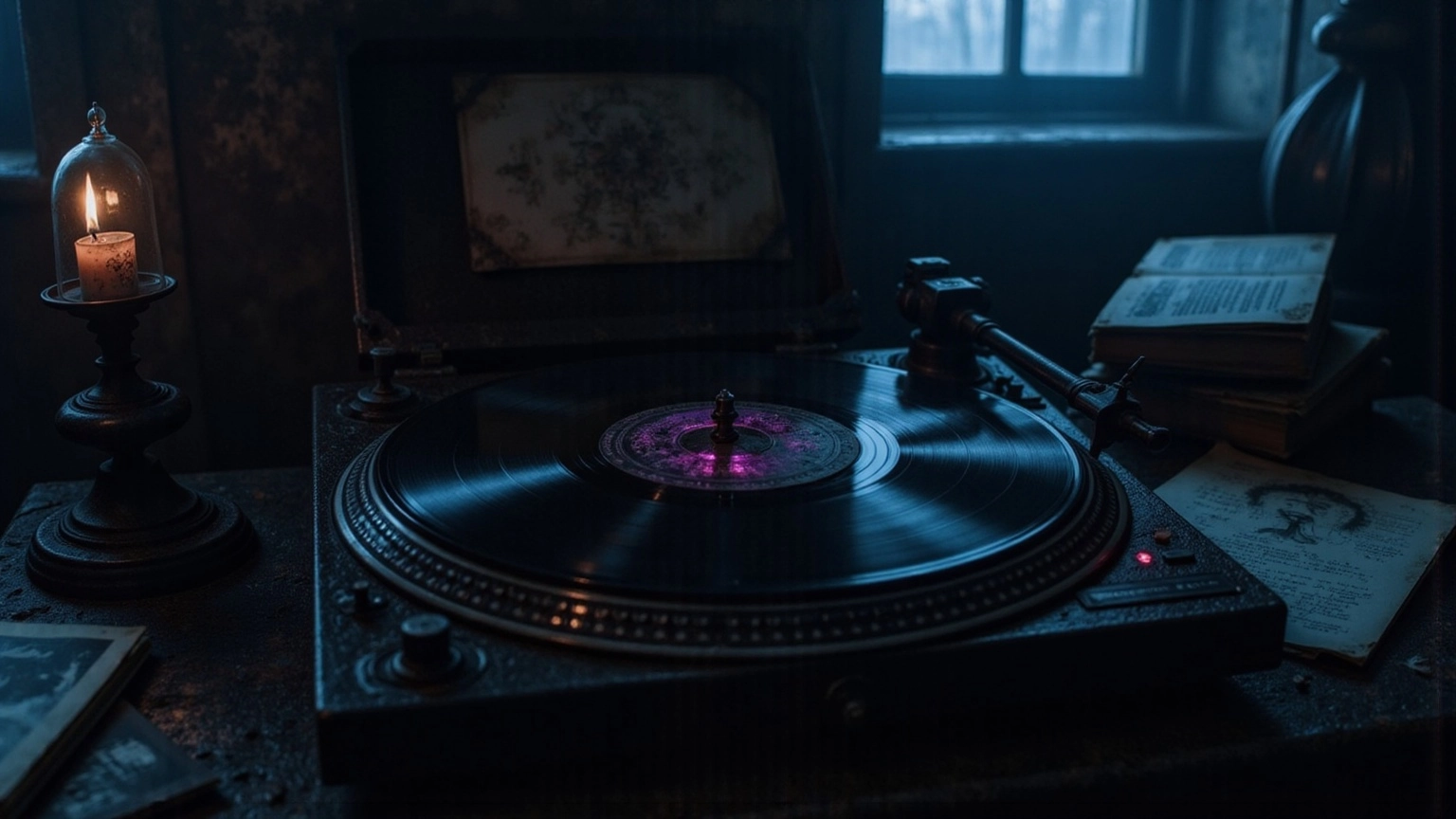
The Sisters of Mercy: 'Temple of Love' - A Celebration of Gothic Romance
The Sisters of Mercy's 'Temple of Love,' unleashed in 1983, is a quintessential anthem among gothic rock songs that celebrates gothic romance. Pulsating rhythms and Andrew Eldritch's commanding vocals ignite profound feelings of longing and devotion. The lyrics intertwine themes of love and darkness, crafting a narrative that resonates deeply with genre fans. This track exemplifies dark rock's ability to romanticize the shadowy aspects of existence, solidifying its status as a cherished classic.
It spent an impressive 36 weeks on the UK Indie Chart, reaching number one for a week. The enduring popularity of 'Temple of Love' underscores its significant influence on dark music and gothic rock songs, capturing the essence of romanticism through haunting melodies and evocative lyrics.
Much like the quiet sorcery behind natural relief that Darc Arts embodies, 'Temple of Love' beckons listeners to delve into the deeper connections between love, darkness, and the aesthetic of the macabre. It resonates with those who appreciate the cultural significance of cannabis and the allure of elegant darkness.
Are you ready to explore this intoxicating blend of romance and shadow?
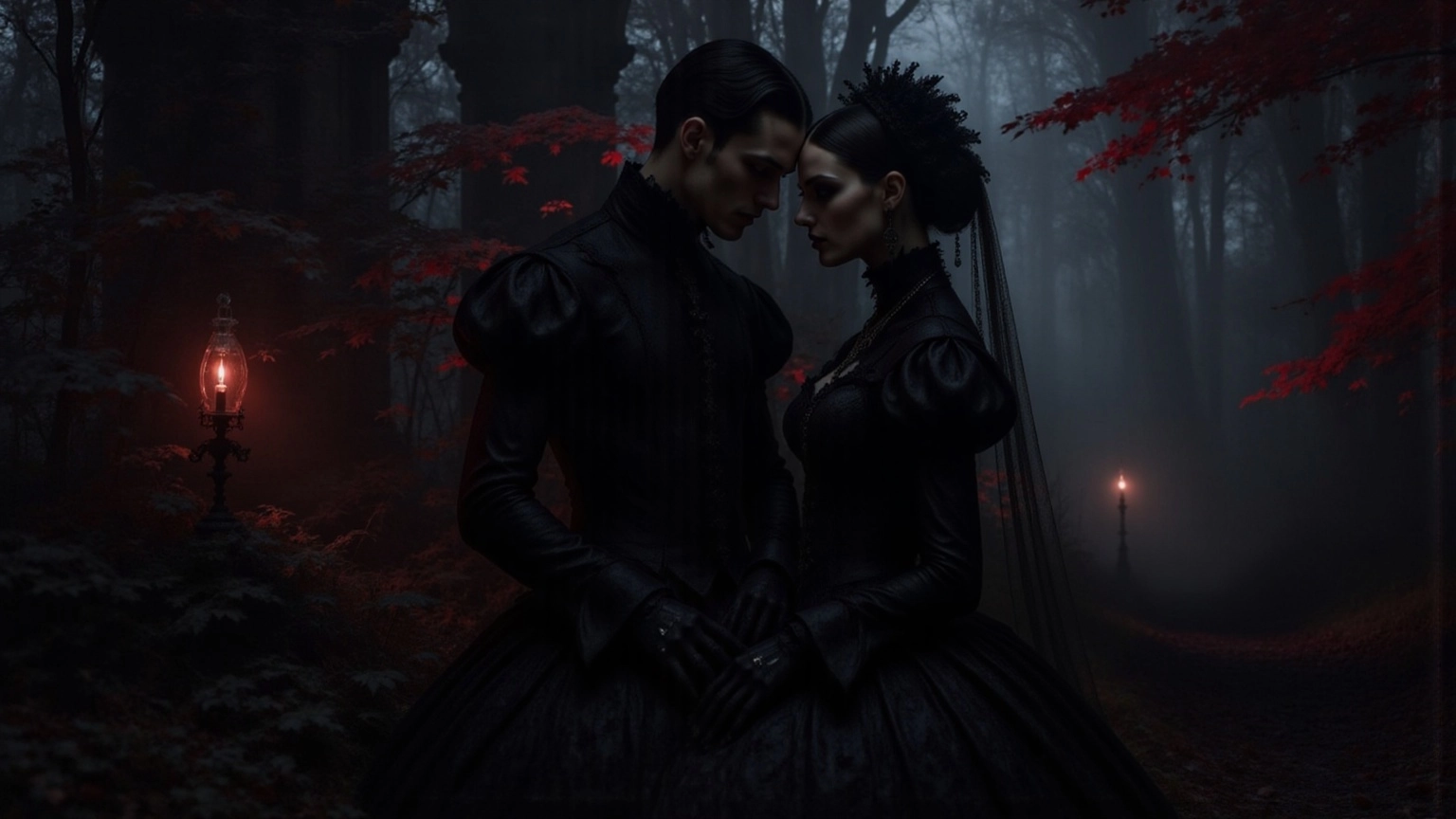
Fields of the Nephilim: 'Moonchild' - A Journey into the Mystical
Moonchild' by Fields of the Nephilim, unleashed in 1987, is not just a song—it's an invitation to a mystical realm. Ethereal instrumentation dances with Carl McCoy's haunting vocals, conjuring an atmosphere steeped in otherworldly allure. What lies beneath the surface? Lyrically, 'Moonchild' plunges into the depths of spirituality and the supernatural, urging listeners to peel back the layers of existence.
This track embodies the genre's intrinsic ties to the mystical, echoing a broader trend in dark music, particularly in gothic rock songs, where spiritual themes resonate with those yearning for a connection to the unknown. The spiritual weight of 'Moonchild' pulls you into a space where beauty and darkness entwine, solidifying its status as a remarkable gem in the alternative music landscape.
Dive deeper—what secrets does it hold for you?
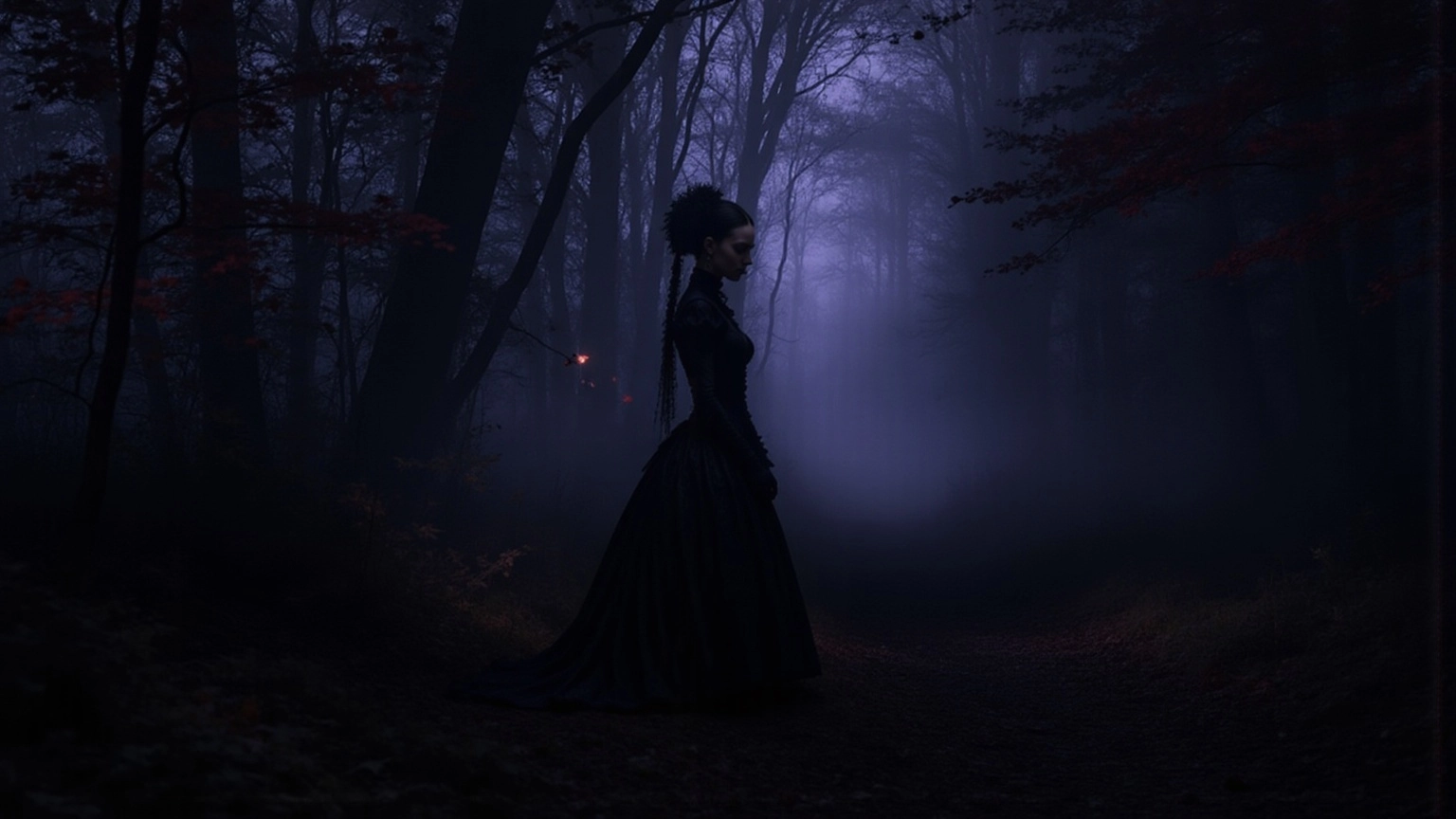
Type O Negative: 'Black No. 1' - The Intersection of Gothic and Metal
Type O Negative's 'Black No. 1,' unleashed on August 17, 1993, is more than just a track—it's a sonic manifesto that fuses gothic rock with metal's raw power. Heavy guitar riffs collide with Peter Steele's deep, resonant vocals, crafting a soundscape that grips and haunts. The lyrics? A twisted dance through love and loss, laced with dark humor and irony, revealing the emotional depths of the genre. This isn't just a song for dark rock fans; it's a siren call for metal enthusiasts, solidifying its status as one of the timeless gothic rock songs.
The alchemy of dark and metal in 'Black No. 1' has reshaped both realms, pushing dark metal into the spotlight as a unique musical force. With eerie melodies and thunderous instrumentation, this track is a must-have for any playlist steeped in darkness and metal. Remember Peter Steele's words? He humorously dismantles the dark aesthetic stereotype, adding layers to its cultural significance. This blend of shadowy themes and metal's intensity resonates with the lifestyle championed by Darc Arts, inviting cannabis lovers to dive deep into the profound, artistic elements of their experiences.
So, are you ready to embrace the darkness? 'Black No. 1' isn't just a song; it's an invitation to explore the depths of your own aesthetic, where music and cannabis culture intertwine in a haze of creativity and introspection.
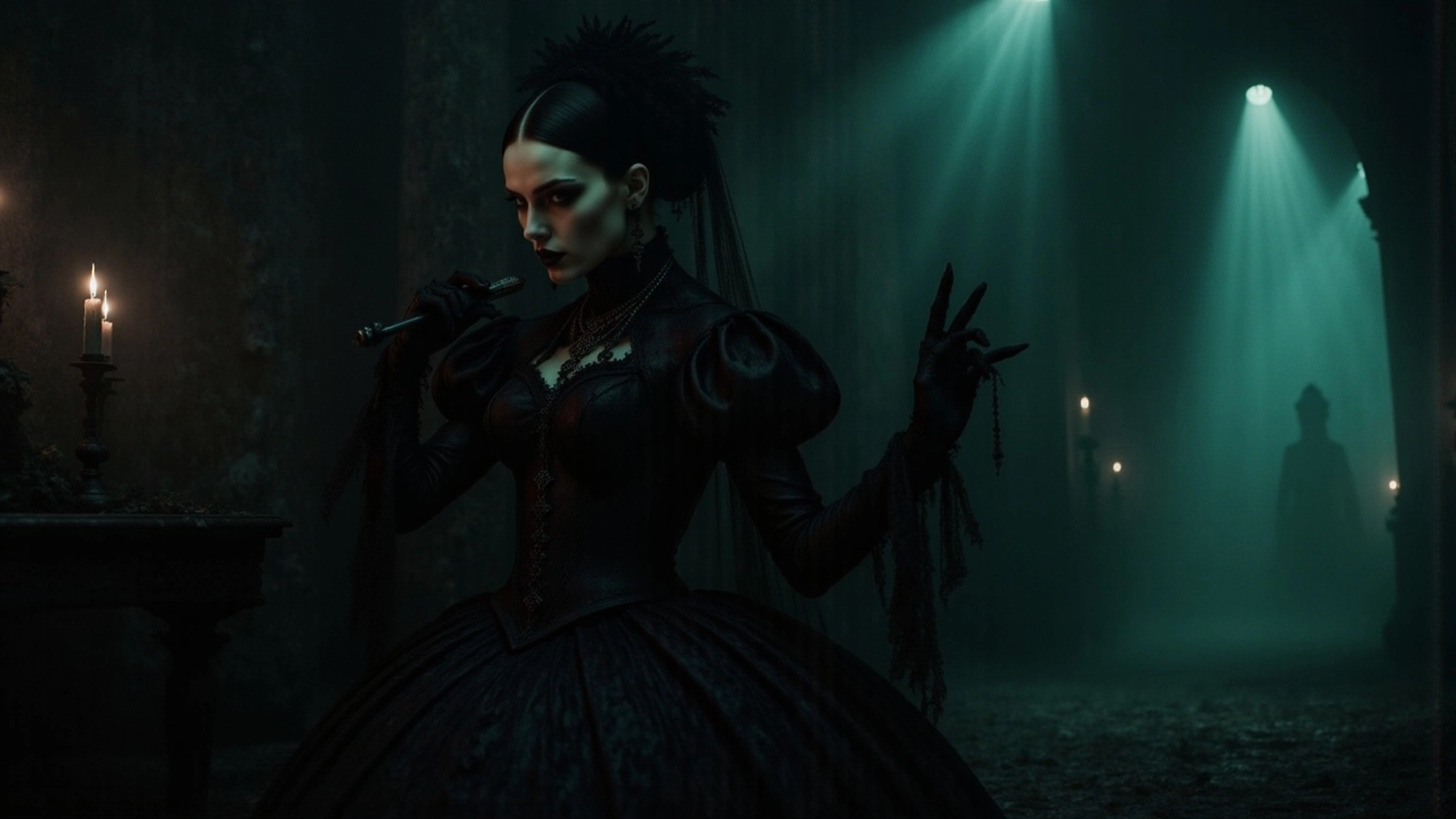
My Chemical Romance: 'Helena' - A Modern Gothic Classic
Helena' by My Chemical Romance, unleashed in 2004, emerges as a contemporary dark classic that strikes a chord with a new generation of fans. This song, with its anthemic choruses and haunting lyrics, delves into the depths of loss and remembrance, capturing the raw emotional turmoil of grief. Penned by Gerard Way in tribute to his grandmother, 'Helena' embodies the profound impact of personal loss, amplifying its emotional resonance.
My Chemical Romance's theatrical flair and dark aesthetic not only pay homage to rock tradition but also inject a contemporary twist that broadens its allure. This track exemplifies the evolving landscape of dark motifs in modern music, particularly through gothic rock songs, showcasing their enduring ability to inspire and influence emerging artists.
With over 681 live performances, 'Helena' has cemented its place as one of the band's most iconic anthems—a staple in their electrifying shows. It soared to number 20 on the UK singles chart and hit number 33 on the Billboard Hot 100, underscoring its cultural significance and pivotal role in popularizing emo music during the 2000s.
The music video, weaving a haunting narrative of loss and revival, has garnered acclaim for its artistic prowess, further establishing 'Helena' as a defining track that encapsulates the essence of contemporary dark motifs in music. This connection to themes of loss and remembrance resonates with the lifestyle championed by Darc Arts, where elegance and wellness entwine with the dark aesthetic.
Dare to dive deeper into this world?
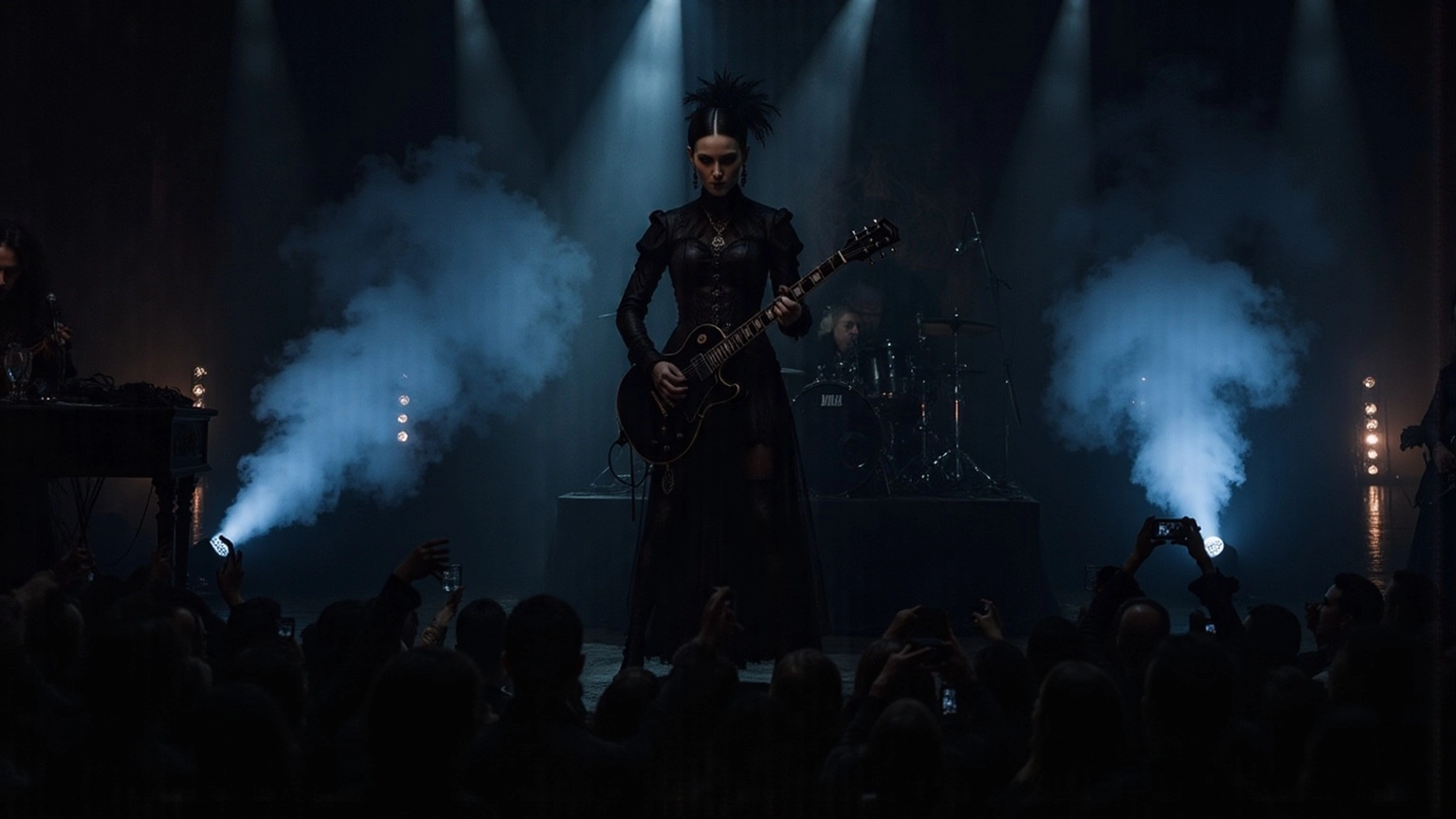
AFI: 'Miss Murder' - Theatricality Meets Gothic Aesthetics
Miss Murder' by AFI, released in 2006, is a prime embodiment of gothic rock songs' theatrical allure. The pulsating rhythms and Davey Havok's electrifying vocals ignite an atmosphere thick with urgency. Delving into fame's intoxicating grip and obsession's dark embrace, the lyrics unfold like a shadowy tale. This track doesn't just echo the captivating essence of dark music; it intertwines theatrical flair with raw emotional depth, much like gothic rock songs. Its impact on dark aesthetics is profound, showcasing the genre's knack for exploring fame's sinister allure while delivering an immersive experience.
A study reveals that around 65% of dark tracks grapple with fame and obsession, underscoring the genre's obsession with these themes. In interviews, Havok reveals that 'Miss Murder' embodies fame's seductive pull and its lurking dangers, cementing its place in the alternative music landscape. By peeling back these layers, 'Miss Murder' becomes a pivotal exploration of theatricality and dark aesthetics, solidifying its status as one of the essential gothic rock songs for genre aficionados.
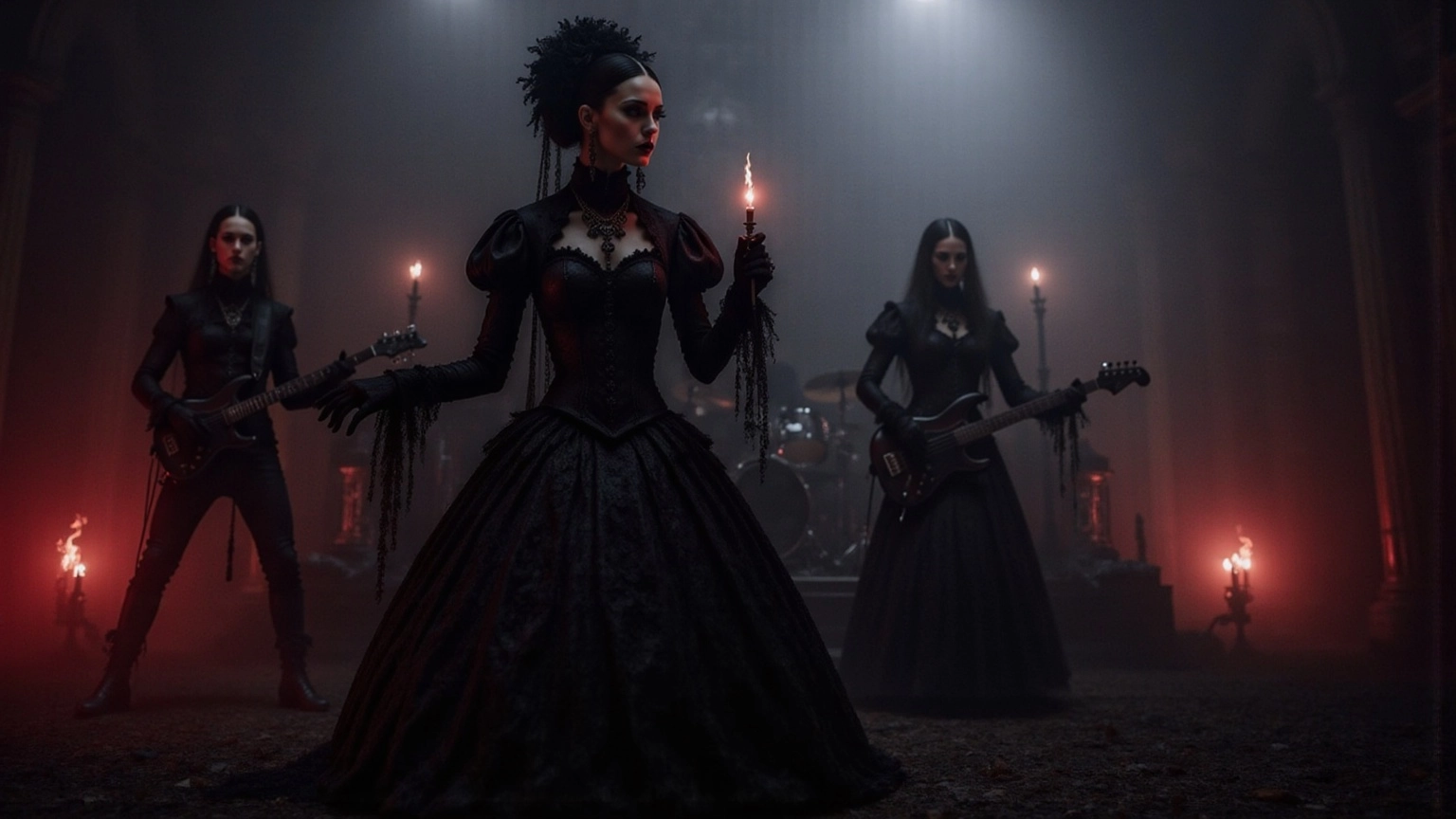
The Damned: 'Eloise' - A Timeless Gothic Masterpiece
Eloise' by The Damned, unleashed in 1986, stands as a dark music masterpiece that still grips hearts. This track boasts rich instrumentation, with session legends like Jimmy Page and John Paul Jones weaving their magic, while Dave Vanian's haunting vocals stir a deep sense of melancholy and yearning. The lyrics unfold a poignant saga of love and loss, capturing the emotional complexity that defines dark rock.
Paul Ryan penned 'Eloise' in a mere three days, inspired by Richard Harris's arrangement of 'MacArthur Park,' adding a fascinating layer to its artistic lineage. This song doesn't just exemplify the genre's magnetic pull; it embodies the emotional themes that pulse through dark music, making it a must-listen for true aficionados.
Rat Scabies felt the song never quite reached completion, while Steve Kutner labeled the recording process a nightmare, underscoring the hurdles faced during its birth. Ultimately, 'Eloise' remains an eternal echo, resonating deeply within the realm of gothic rock songs—an invitation to dive into its haunting depths.
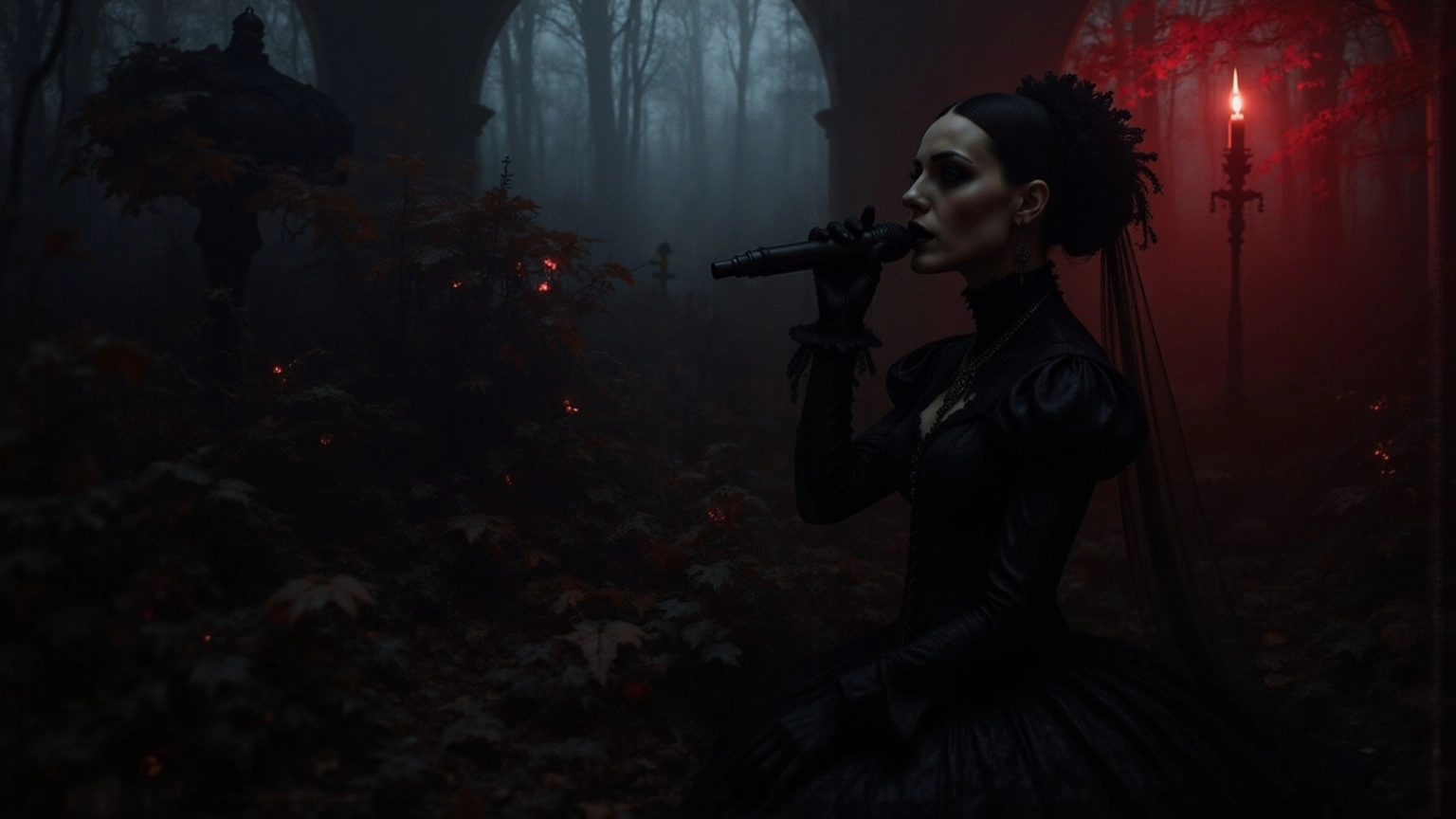
Conclusion
Gothic rock songs are more than mere music; they are a rich tapestry of sound and emotion, drawing listeners into a realm drenched in darkness and beauty. Each track stands as a cornerstone of the genre, revealing the haunting melodies, poignant lyrics, and profound themes of love, loss, and isolation that define gothic rock.
From the chilling allure of Bauhaus's 'Bela Lugosi's Dead' to the modern classic 'Helena' by My Chemical Romance, these songs encapsulate gothic rock's essence and its evolution through the decades. The fusion of punk energy with dark aesthetics in Siouxsie and the Banshees' 'Spellbound' and the heavy metal influences in Type O Negative's 'Black No. 1' showcase the genre's versatility, resonating with diverse audiences. Each song tells a story, contributing to the cultural significance of gothic rock, influencing countless artists and shaping the landscape of alternative music.
As listeners dive into these essential tracks, an opportunity arises to reflect on the deeper connections between music, emotion, and the human experience. Embracing the shadows within these songs fosters a greater understanding of life's complexities, love, and the allure of the macabre. Whether you're a long-time aficionado or a newcomer, the invitation to explore these haunting soundscapes is ever-present, offering a chance to discover beauty in darkness and the power of music to evoke profound feelings.
Frequently Asked Questions
What is the significance of Bauhaus's song "Bela Lugosi's Dead"?
"Bela Lugosi's Dead," released in 1979, is a defining anthem of gothic rock that embodies the dark rock genre's allure. Its minimalist instrumentation and chilling vocals create an eerie atmosphere, making it a cornerstone of dark culture and influencing many artists.
How does "Bela Lugosi's Dead" reflect themes of horror and darkness?
The song weaves a narrative that revels in the macabre, celebrating themes of death and decay. It invites listeners into a world where shadows dance with the grotesque, appealing to those who find beauty in horror.
What impact has "Bela Lugosi's Dead" had on music and culture?
The song has inspired artists like The Cure and Siouxsie and the Banshees and is ranked #60 in Rolling Stone's 'The 100 Greatest Debut Singles of All Time.' Its haunting presence in the film "The Hunger" (1983) further cements its cultural significance.
What does The Cure's song "A Forest" explore?
"A Forest," released in 1980, is a haunting exploration of isolation and yearning, characterized by a repetitive guitar riff and Robert Smith's ethereal voice. The lyrics reflect a desperate search for something elusive, mirroring feelings of disconnection.
How does the ambiguity in "A Forest" enhance its meaning?
Conflicting interpretations from Robert Smith regarding the song's origin—whether it stems from a childhood nightmare or is merely a reflection of a forest—add layers of meaning, inviting deeper contemplation from listeners.
What cultural impact has "A Forest" had?
The song's sparse lyrics and haunting atmosphere have left a lasting mark on listeners, and its presence in films and TV shows reinforces its cultural significance. Its final moments evoke existential dread, emphasizing themes of isolation and futility.
What is the essence of Siouxsie and the Banshees' song "Spellbound"?
Released in 1981, "Spellbound" is a vibrant fusion of punk energy and dark aesthetics, featuring driving rhythms and Siouxsie's distinctive vocals. The lyrics capture themes of obsession and desire, showcasing the fluidity of dark music.
How does "Spellbound" contribute to the evolution of dark music?
The song's inventive guitar work and energetic arrangement create a powerful link between punk's raw intensity and gothic elegance. It has influenced the development of subgenres like Darkwave and Deathrock, reflecting cultural currents of introspection and existential disillusionment.
